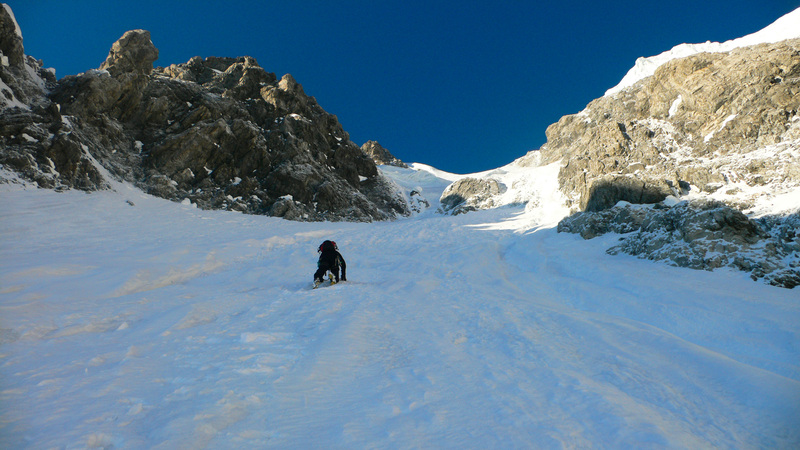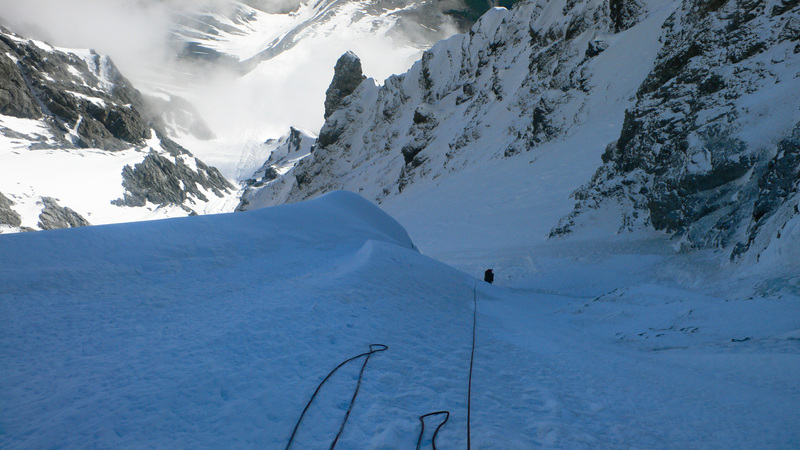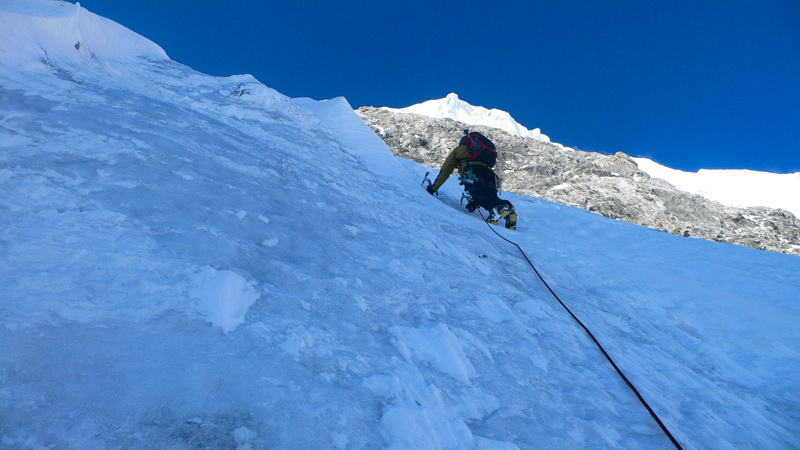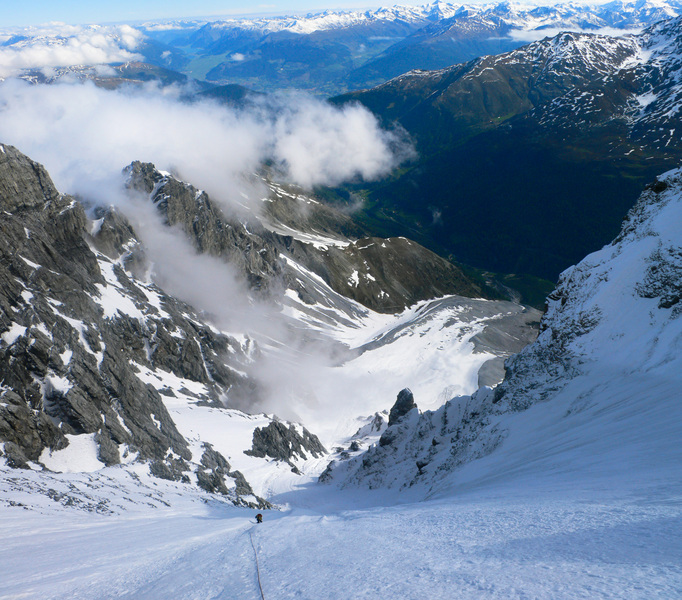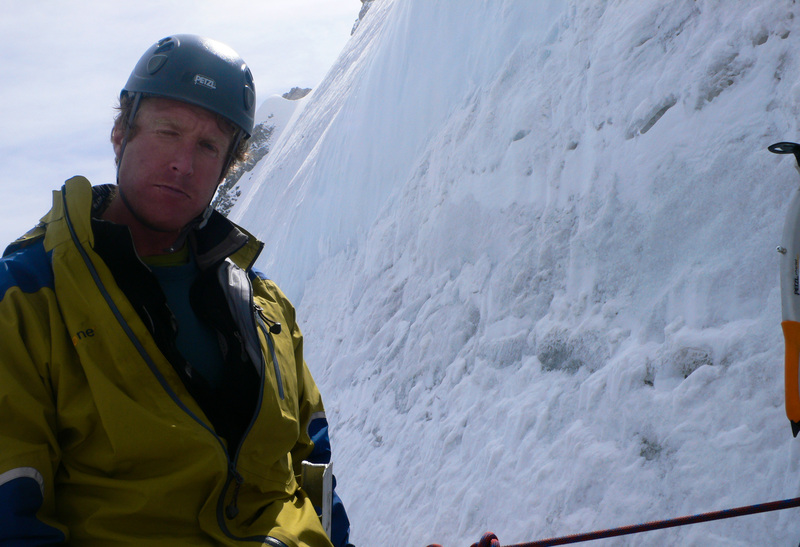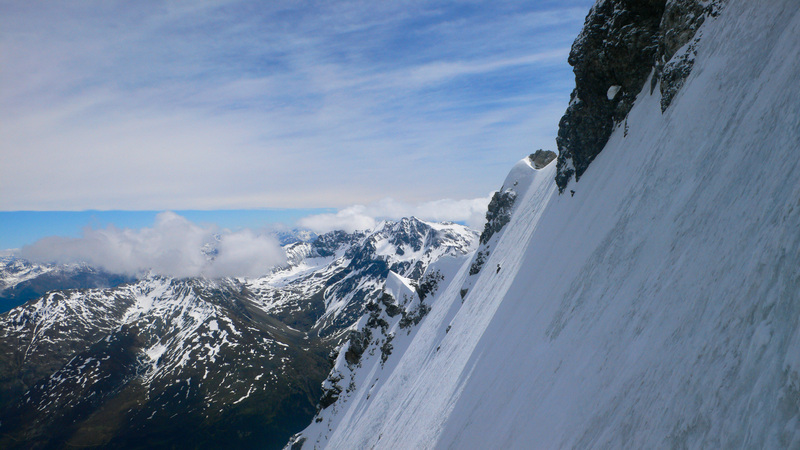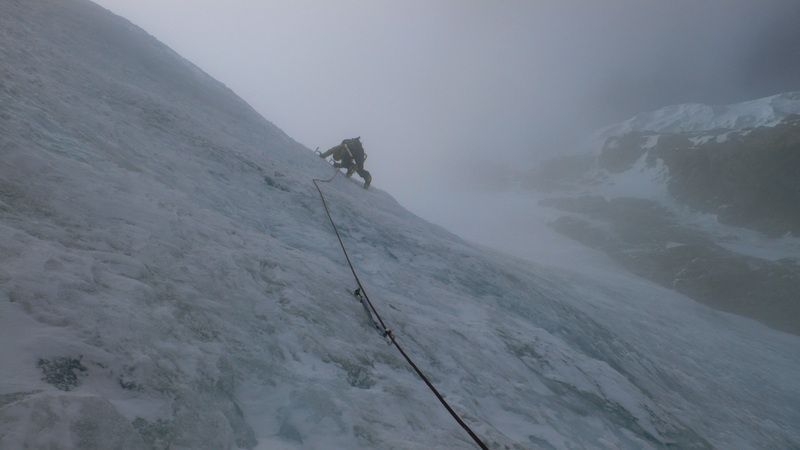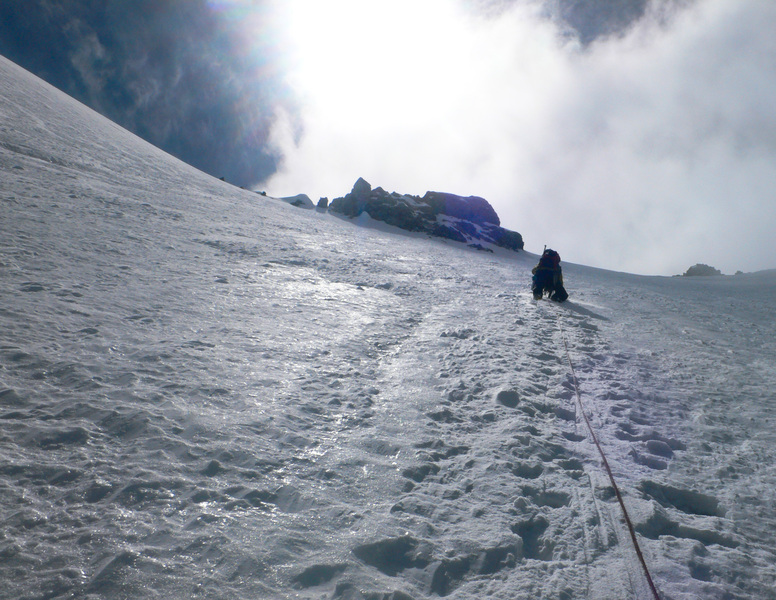Ortler, North Face
Friends: DanLocation: Ortler
Elevation gain: 2400m = 1200m + 1200m
North Wall (D+, 1200 meters, ice to 70 degrees)
Dan and I were hoping to go rock climbing for a couple of days in the Dolomites. There had been an extended period of incredible, high pressure weather. But "that's life" as they say, so inevitably as the weekend approached the high pressure ridge crumbled and rain and clouds pressed into Italy from the north. Reading the forecast closely, it appeared there would be showers and clouds here and there, but there wouldn't be a sustained frontal system. Also, temperatures would be well below average for the next days. A cog turned in my mind: this is a perfect forecast for north face climbing! A phone call to the Tabarettahütte, and we were reserved for Sunday night there. Climbing the North Face of the Ortler was on our "tick list" for the summer, and we had high hopes that we would get to do it now.
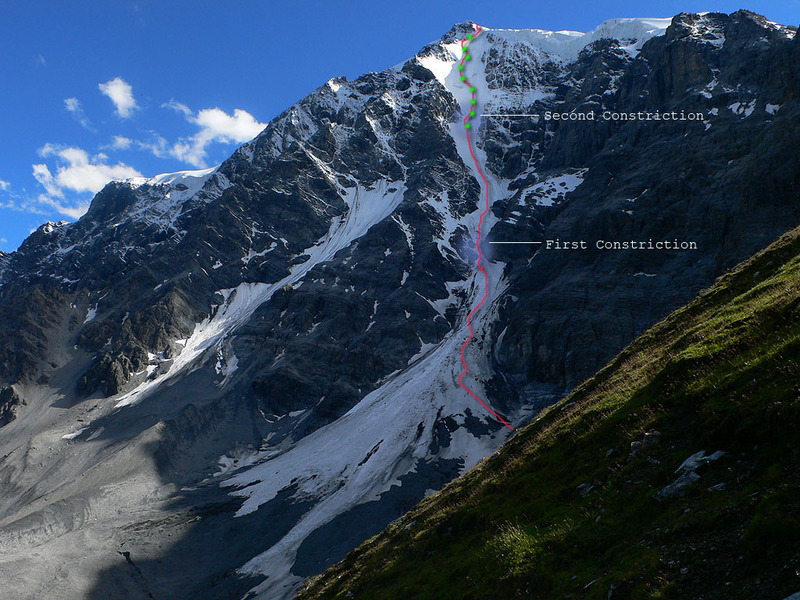
The 1200 meter (4000 feet) north face, taken in July 2007 on the way down from another climb.
Positioning
We still left Munich fairly early. I wanted to be able to scope out the face before clouds came in (one feature of this kind of unstable weather situation is that mornings are often clear, evenings are rainy). We drove to Sulden and ate some sausage by the car, wondering at the oddly deserted town, stuck between seasons. I spent a long while sharpening my tools and crampons, knowing how hard the ice can be on these avalanche-pounded walls.
It was sunny, but by the time we were walking it grew cloudy and a bit cold. My dim understanding of the trail systems there had us hiking up a low angle trail below the Langensteinlift. But then we grew impatient and took narrow, steeper trails that shortcut the interminable switchbacks. But a side effect was that we missed a turn off for a gradual trail going into the huge basin below the Martltferner (Glacier). Finally we reached the top of the lift and it began to snow.
We'd climbed about 600 feet too high, and had to descent to the west. Oops!
In sometimes heavy snowfall, we made our way to the Tabarettahütte. Two parties came down, having enjoyed a climb of the Via Normale. They said another party had climbed the North Face too. We had the hut to ourselves, along with the caretaking family, who were very nice. We passed the hours listening to "This American Life" on Dan's iPhone, looking out at the snow gathering on the benches, and peeking at the route whenever we could. A hearty meal of Spiegeleier and Kaiserschmarm sent us to an early bed with warm bellies. The caretaker told us we needed to leave by 2:30 am for a safe climb, and left out tea and bread for the "morning." Paranoid, I borrowed an extra alarm clock from the caretakers.
Launch
I slept well, and woke up with some reluctance. Sleeping is nice! But our things were ready, we just had to eat. Seeing the cold blue peak under a starry sky outside got our engines going, and soon we tromped off on a trail that traversed the hillside to reach the Marltferner below the face. Eventually the trail disappeared, and we clomped more clumsily across steep scree, and then finally continuous snow. We climbed a massive avalanche cone beneath the "first constriction" on the route, and enjoyed the way things steepened pleasantly as we passed through this constriction. It was typical "3 o'clock position" terrain: one boot front pointing, another resting sideways, with two tools in the "piolet panne" position.
Dan climbing in the "middle third"
But in here we made a mistake that seems curious now, and especially when looking at photos of the phase from a distance. We got the idea that the main gully, which went around a corner, was a dead end, as in going around the corner it seemed peter off into snowy cliffs. So we climbed up and left to cross over a ridge, thinking THAT was the main couloir. Steadily up for 200 meters, then reaching the ridge and trying to find a way down, we realized we were as uncertain about THIS side of the ridge as the other side. Sigh. The seemingly uniform face had, for us, broken up into a maze of gullies and dead ends. Trying to sort out what we saw with a picture of the face brought no success. After a somewhat random pitch of rock and snow on the buttress, we decided to turn around and investigate the "false" couloir. 20 minutes of sometimes tense downclimbing brought us back to a point we could reclimb. What joy when we recognized it was the right way!
Now we were climbing the "middle third" of the face, staying to one side or the other of various avalanche runnels to enjoy good hard snow and "snice." It was full light now, and we realized we'd squandered our very early start with the wrong turn, but if we could get through the second constriction on the face before long, we'd be reasonably safe to continue. At this point an awkward situation reared up: Dan had to "deliver a package." But it required removing his harness, pulling down his bibs...all things that just don't make sense on a (now) continuous 60 degree wall! I hoped (in vain, as it turned out) that at the base of one of the seracs above we could find an ice cave.
Along in here we became acquainted with the occasional buzzing missile of rock or ice. There were three or four of these that came pummeling by during our time in the middle third, each making a slightly different fluttering/buzzing sound, never pleasant to hear!
Finally we made it to the base of the second constriction and decided to get out the rope and belay from a safe position well to the side. Dan sent me off and I climbed a 70 degree ice pitch on the right side of the narrow debries funnel. Fantastic! I placed two screws and brought Dan up to the base of another ice pitch 65 meters above. From here, tied into two ice screws, for the first time I could relax a bit and admire our surroundings. Huge ice cliffs loomed above and to the right. Nasty-looking walls with snow and ice filled the frame on the left. I made a little video while Dan climbed. It was 8 am, and we were two-thirds of the way up. The summit at noon sounded about right.
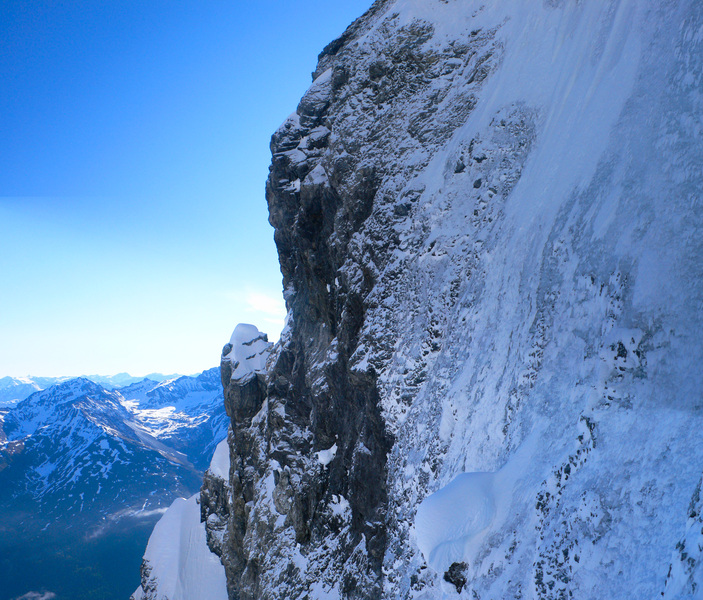
The view to the left of the constriction
Several more pitches, and we reached a serac, which we turned on the left with a short 70 degree spot of ice. Then we trended back right to avoid the steepest part of a serac on the left. We'd entered a period of rote-mechanical work. Climb a pitch, placing 2-3 screws, belay. Repeat. When the snow became deep we really slowed down. On one pitch, Dan basically chopped two vertical troughs for hands and feet through powdery snow to reach good ice underneath. It was of a structure, such that in following I couldn't get any advantage from his steps. I tried to think of various tricks. On the deep snow pitch (with Dan's assent) I would pull myself up and out of a hole with the rope, and eschew solid placements in favor of fast, aided movement. Dan led the next pitch too, after I arrived breathless and sweaty at the belay. At least it had been a fast follow!
Between Dan's extreme need for a bathroom, the altitude, and just plain tiredness, we seemed to be losing the battle to get up and off the route anytime soon. We had to do something about the bathroom situation...we'd laughed plenty about it, but it really wasn't funny any more. Dan would have to stop leading or following, "compose himself" for several minutes, then keep trying. I've rarely witnessed such suffering. Dan really enjoyed the climb, but at the time I was worried that the patina of that extremely uncomfortable experience would color the whole wall experience for him.
Two more really fantastic ice pitches got us over the last serac. This was the best place in the wall, high enough that escape below is impossible, that the drama of the scene is unparalleled, but also where the hope of lessening difficulties can be entertained. We'd both experienced frightening muscle cramps while leading, our toes and feet were beat up by the ice, our stamina was lessening, and gathering clouds were playing on our nerves.
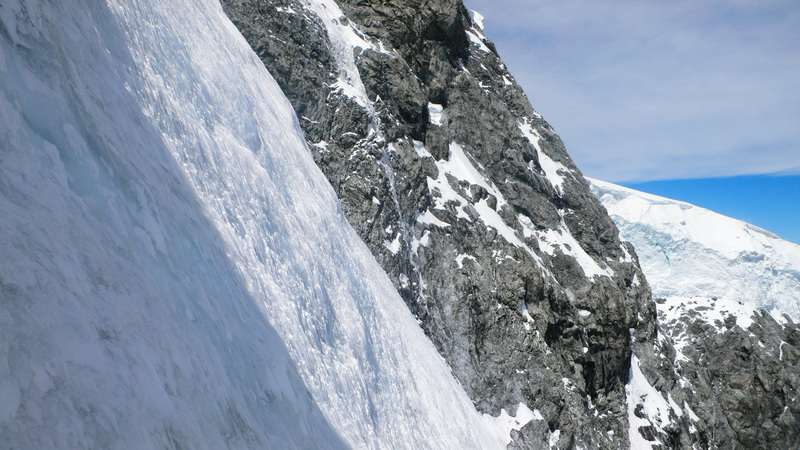
Looking right at the serac belay.
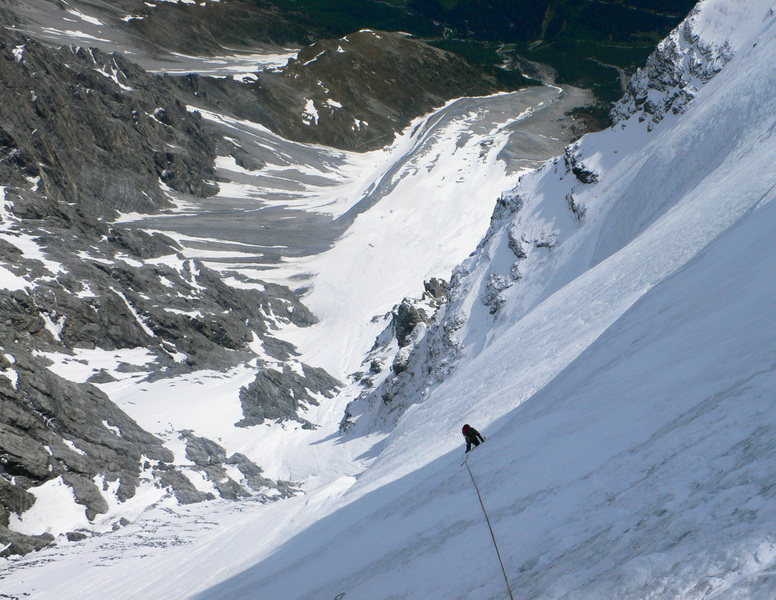
Looking down to Dan at the serac belay.
Eventually, I gained the top of the route on the Martlgrat ridge, building a belay with picket and axe in good snow. Dan arrived, somewhat miserably. But finally he could do what he needed to do here if we cleared a flat spot on the ridge. We did this, and carefully stowed all his accessories: pack, rack, tools, harness. He relief was unbounded, and boy was I glad for him too.
Fog came in now, and would remain. I was surprised to see it was after two o'clock. Knowing we had a long descent, and worried about finding that descent in a whiteout on the summit plateau, We decided to unrope and travel together. The thing was, we weren't getting a significant bonus for the follower in the form of good steps. Either it was more ice than snow, or the steps would collapse. So the follower worked almost as hard and took almost as long. We both knew how tired we were, and that we needed to be careful. But only one person moving slowly and carefully at a time was a huge time sink we couldn't afford any more. So we climbed unroped for probably 100 meters of vertical gain, and a significant time savings. Some steeper terrain combined with a change of medium incited me to ask for a picket belay into the fog above. Happily, it was just a 20 meter pitch to where the angle fell back dramatically and we could walk the rest of the way to the summit within 20 minutes.
The route took so much energy for us. I asked myself several times, what was I thinking trying such a big route early in the season, when I've barely carried a pack at all? But a good sit down at the summit, some still-warm tea, and we felt much refreshed. Sadly, we were in a pea-soup fog. Occasional cold bursts of wind did nothing to clear it. I would have loved to have seen the view to the south again, with Monte Zebru and the Königspitze.
Re-entry
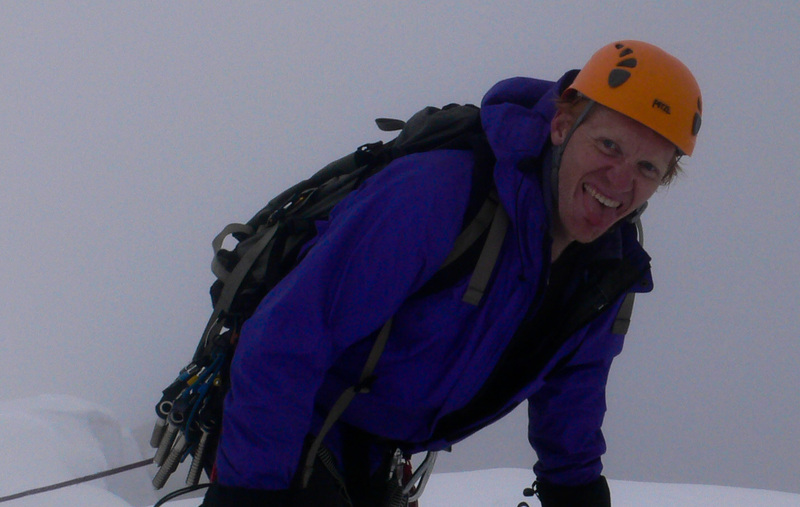
Michael, crazed at the summit
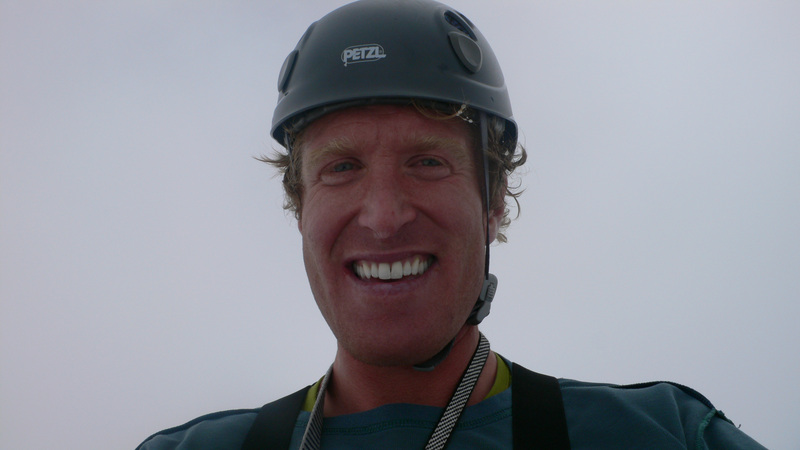
Dan Protz
Now, how to get down. At first, tracks led south, as they should. But soon they disappeared, and we were on a large, mostly flat plain. Looking at the map, I felt we'd traveled south then west enough. Putting Dan in front as a guide in the whiteout, I navigated with compass to the north. Just as we were discussing that we'd know we were too far east of north if we came to massive serac cliffs...we came to a massive serac cliff! Dan stepped back very quickly, noting how much those things can overhang. So that became our plan in the fog: head north, then at looming drop-offs tack westward. A bit above the bivouac shelter we dropped out of the cloud and could see the way easily. Praise the Lord! I was especially happy we hadn't gone too far west and descended a zone of glacier marked by massive cliffs and gaping slots.
We heard Italian voices in the bivouac shelter, our first "contact" all day, but we didn't disturb them. Hiking easily down to the Tabaretta Ridge, we enjoyed the Swiss and Italian mountains, visible in exceptionally clear air beneath a long gray cloud that extended over our own peak.
We downclimbed the somwhat nervy Tabaretta Ridge, with it's polished but very solid rock. We used an aid sling at the same place I had two years before to find a foothold below an overhang on the narrow crest of the ridge. But this descent went on and on and on. By the time we reached the Payerhütte, I was absolutely wiped. Walking up a minor hill made me feel like a 90 year old. I resented the tiniest elevation gain on the trail!
We kept going along the ridge and finally turned down into the basin that leads back to the Tabaretta Hütte. So much postholing, rotten wet snow and scree skiing felt like obstacles just put in the way to make life hard. But we reached the hut at 8 pm, going in for a beer and full dinner. Unlike the night before, the Hut was full of packs and boots and people. At least one pair were planning for the Nordwand. A restful couple of hours gave us the chance to sign the famous "route book," to rehydrate and absorb some energy from food. Setting off for the car, we were both considerably refreshed. I woud get a bit ahead, then turn off my headlamp and sit in the dark to admire the stars and the snowy peaks. After another eternity we reached the car at the base of the Langenstein lift. It was midnight, and 6 am (after several naps on the side of the road) would see me back in Munich, ringing the doorbell to wake my wife because I forgot my key.
As I write this, it's 48 hours since we awoke to stumble out onto that cold wall, and it feels as if an entire galaxy of experiences has happened since then. A huge thanks to Dan for being such a strong and safe partner on a route that exceeded so many metrics of our experience.
